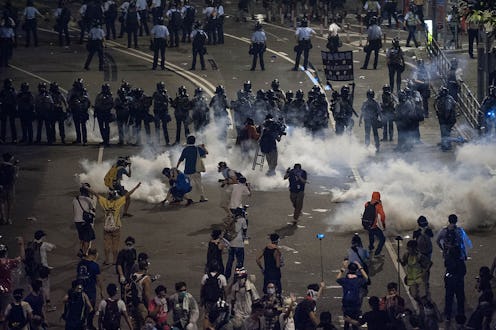News
The Hong Kong Protests, Explained
If you've been following the recent protests in Hong Kong, you've probably seen some dramatic scenes — throngs of people standing up for democracy, in spite of threats made by their police and government. To an outsider, though, the situation may seem opaque, so you may be wondering: What's happening in Hong Kong, and just how long have these tensions been building?
Scenes from the city's normally pulsing financial district on early Monday morning were intense, to say the least — protesters standing up for what they believe to be their human rights, faced with a violent backlash from police forces. Sounds familiar, right? Basically, protesters are trying to stymie the financial hub in order to force their demands to be recognized. Whether it'll prove successful remains anyone's guess.
The protests aim to end a crucial aspect of China's top-down control over Hong Kong. The public should vote for whomever they want as chief executive, the protesters of Occupy Central argue, rather than being slaves to a ballot chosen by the Chinese government. The citizens of Hong Kong have spent a long time under the control of outsider governments, and they're tired of it.
How Hong Kong Got Here
It took a very long time for the people of Hong Kong to achieve anything like local control over their government. Now tethered to China, they still really don't have it, but the Chinese government is at the very least closer than who was formerly in charge of the region — from 1841 to 1997, Hong Kong was a colony of the British Empire, having been handed over by China in the aftermath of a trade dispute over opium production.
The handoff was made official by the Treaty of Nanking, a more or less entirely one-sided document — China had to compensate the British, both financially, and by giving them Hong Kong, which was valued as a port destination, and received no favorable concessions in the other direction.
And that's how it was for, well, about 156 years — Britain returned control of Hong Kong to China in 1997. Framed in this context, the fiery discord and devotion to pro-democracy protest in the here and now makes more sense — Hong Kong's been waiting for a moment like this for a long time.
Promises Made, Promises Broken?
A very particular promise was made to the people of Hong Kong when China regained control in 1997. The 2017 elections were meant to be the first time Hong Kong would be able to directly vote for its top elected officeholder, known as the "chief executive." This was a pledge laid down at the time of the transfer from British to Chinese rule, and they've been reassured about it since — in 2007, the Chinese government once again affirmed that "universal suffrage" was coming to Hong Kong.
But as the date of that momentous election has grown nearer, the government in Beijing has made moves perceived as consolidating power ahead of the vote, and it's believed that they intend to renege on the agreement through the candidate nominating process.
The Chinese parliament (called The Standing Committee of the National People's Congress, quite a mouthful) approved a framework for the 2017 elections which would limit the number of candidates to only two or three, according to Reuters, and says they must be approved by a nominating body which figures to be chock-full of loyalists to China's ruling Communist Party. In other words: China vetoed true democracy in Hong Kong.
Taking to the Streets, and Being Met With Force
The protest movement now underway has a name that should sound very familiar — "Occupy Central With Love and Peace," or simply Occupy Central for short. Central is the name given to Hong Kong's financial district, and not unlike Occupy Wall Street, the concept is to force attention, and to grind some functions of the financial sector to a halt.
That said, the response from Hong Kong police was swift and surprisingly heavy-handed right out of the gate. Protesters who peacefully settled in front of Hong Kong's governmental headquarters Friday, also located in Central, were met with rubber-bullet filled rifles, and perhaps most controversially, teargas. The police's use of teargas on the protests drew a lot of attention, and sharp criticism from the public — its use on Hong Kong's citizenry is rare, in relative terms, having last happened during a World Trade Organization protest in 2005, according to the Los Angeles Times.
One Country, Two Systems, Moving Backward?
Central to the conflict is how China envisions Hong Kong moving forward. Given the Chinese government's historically high levels of control over its populace and political system — it's widely recognized as one of the world's most oppressive governments — there's a real fear that the government will try to consolidate power rather than yield it back. This is a nasty turn of events for Hong Kong, even as compared to its time under British rule.
Basically, the Chinese promise of "one country, two systems" was a means to convince Hong Kong's populace they'd eventually achieve the ultimate freedom of direct democracy for all. Now, with the parliament seemingly balking at the prospect, it's feared that China may be planning to tighten and strip away freedoms rather than expand them. It's not hard to see why people have taken to the streets — this could be a pivotal moment in the territory's history, and a big part of the public wants their voices to be heard.
Images: Public Domain/Wikimedia Commons; Getty Images (3)
